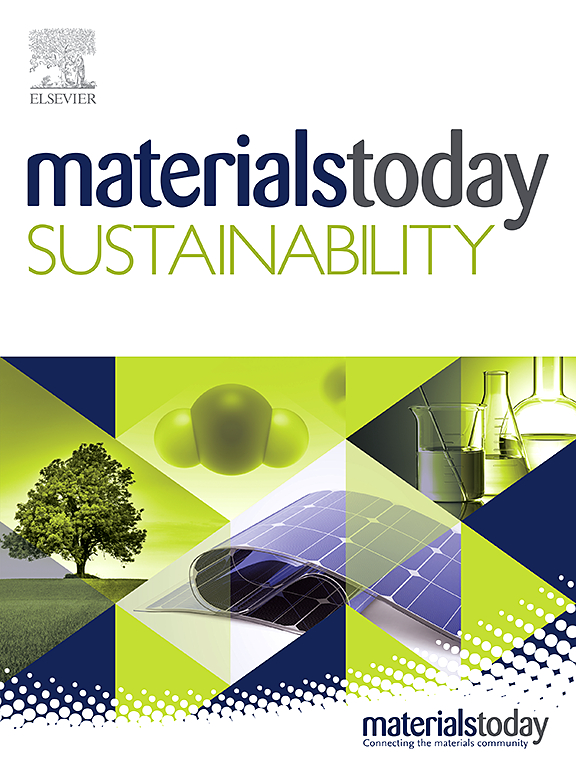利用微波辅助水热法合成的 Ti3C2Tx/rGO/Pt 三元复合材料提高多巴胺检测能力
IF 7.1
3区 材料科学
Q1 GREEN & SUSTAINABLE SCIENCE & TECHNOLOGY
引用次数: 0
摘要
通过微波辅助水热法制造了 Ti3C2Tx MXene(M)和还原型氧化石墨烯(rGO)与铂纳米颗粒(Pt NPs)的三元复合材料,从而开发了一种新型多巴胺(DA)检测电化学传感平台。MXene 的优异导电性和丰富的表面化学性质为电化学反应提供了丰富的活性催化位点,而 rGO 的大表面积则为离子和电子通路提供了便利。将 rGO 集成到 MXene 片材中,形成 MXene-rGO (M_rGO)异质结构复合材料,为二维异质结构带来了长期稳定性,同时提供了额外的电子通路并显著提高了导电性。铂氮氧化物协同提高了电化学传感器的电催化活性。三元纳米复合材料的铂氮氧化物重量百分比(wt.%)从 5 到 20 不等。通过 X 射线衍射 (XRD)、场发射扫描电子显微镜 (FESEM)、能量色散 X 射线光谱 (EDX)、拉曼光谱 (RAMAN) 和 X 射线光谱 (XPS) 对样品(rGO、M、M_rGO 和 5-20 wt% Pt@M_rGO)进行了表征。在 0.1 M 磷酸盐缓冲溶液(PBS)中,使用循环伏安法(CV)和微分脉冲伏安法(DPV)分析对样品进行了电化学评估。分析表明,含有 5 wt% Pt NPs 的三元复合材料(5% Pt@M_rGO)显示出均匀的 Pt NPs 分布,在 CV 研究中,DA 氧化的氧化峰最高。在 MXene 和 rGO 的协同作用下,金属纳米粒子的存在使得 DA 传感器的线性范围从 1 μM 到 14 μM,检出限为 0.147 μM。该传感器具有出色的选择性、可重复性(RSD 值为 8.10%)、可重复性(RSD 值为 2.46%)和 14 天的出色稳定性。在人体尿液样本中,该传感器表现出卓越的 DA 回收率(88.62%-110.65%)。这项研究通过引入一种快速、简便、高效的三元复合材料制造方法,极大地推动了 DA 检测电化学传感器的发展。所制造的传感器具有高灵敏度、出色的选择性和稳健的电化学性能,为人类和行为健康的进步提供了宝贵的见解。本文章由计算机程序翻译,如有差异,请以英文原文为准。
Enhanced dopamine detection using Ti3C2Tx/rGO/Pt ternary composite synthesized via microwave-assisted hydrothermal method
A novel electrochemical sensing platform for dopamine (DA) detection was developed by fabricating the ternary composite of Ti3C2Tx MXene (M) and reduced graphene oxide (rGO) with platinum nanoparticles (Pt NPs) through microwave-assisted hydrothermal heating. The exceptional electrical conductivity and rich surface chemistry of MXene provide abundant active catalytic sites for electrochemical reactions, while the large surface area of rGO facilitates ion and electron pathways. The integration of rGO in the MXene sheet, forming MXene-rGO (M_rGO) heterostructure composite, imparts long-term stability to the 2D heterostructure while providing additional electron pathways and significantly enhancing conductivity. Pt NPs synergistically increased the electrocatalytic activity of the electrochemical sensor's performance. Ternary nanocomposites were fabricated with different weight percentages (wt.%) of Pt NPs, ranging from 5 to 20. Characterizations of the samples (rGO, M, M_rGO, and 5–20 wt% Pt@M_rGO) were conducted through X-ray diffraction (XRD), field emission scanning electron microscopy (FESEM), energy dispersive X-ray spectroscopy (EDX), Raman spectroscopy (RAMAN), and X-ray spectroscopy (XPS). Electrochemical evaluations of the samples were investigated in 0.1 M phosphate buffer solution (PBS) using cyclic voltammetry (CV) and differential pulse voltammetry (DPV) analyses. The analysis revealed that the ternary composite with 5 wt% of Pt NPs (5% Pt@M_rGO) exhibited a uniform well-distribution of Pt NPs and the highest oxidation peak for DA oxidation in CV studies. The presence of metal nanoparticles, aided by the synergistic effects between the MXene and rGO, resulted in an excellent DA sensor with a 0.147 μM detection limit from 1 to 14 μM linearity range. The sensor demonstrated outstanding selectivity, reproducibility (RSD values of 8.10%), repeatability (RSD value of 2.46%) and, excellent stability over 14 days. In human urine samples, the sensor exhibited excellent DA recovery (88.62–110.65%). This study significantly advances the development of electrochemical sensors for DA detection by introducing a rapid, facile and, efficient method for fabricating ternary composites. The fabricated sensor exhibited high sensitivity, excellent selectivity, and robust electrochemical performance, offering valuable insights into human and behavioral health advancements.
求助全文
通过发布文献求助,成功后即可免费获取论文全文。
去求助
来源期刊

Materials Today Sustainability
Multiple-
CiteScore
5.80
自引率
6.40%
发文量
174
审稿时长
32 days
期刊介绍:
Materials Today Sustainability is a multi-disciplinary journal covering all aspects of sustainability through materials science.
With a rapidly increasing population with growing demands, materials science has emerged as a critical discipline toward protecting of the environment and ensuring the long term survival of future generations.
 求助内容:
求助内容: 应助结果提醒方式:
应助结果提醒方式:


